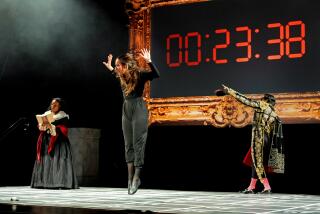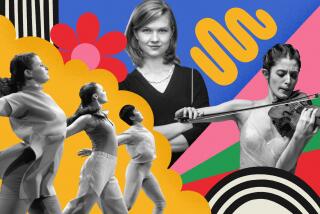The Notes Fly With a Bit More Fury
- Share via
Evgeny Kissin, magnificent pianist though he is, can give the impression that he is not quite of this world. His hair and his playing defy gravity. The robotic bows he takes after each piece are so mechanically stiff and undemonstrative that one wonders if he might be deaf to the wild applause he inevitably receives. Last season, when he gave a Chopin recital in the Dorothy Chandler Pavilion, he played wondrously yet weirdly, as if so trapped in the composer’s work that he was trying to break free by distending or exploding phrases.
Thursday night, Kissin returned to Southern California to open the Philharmonic Society of Orange County’s series at the Orange County Performing Arts Center, this time with a serious program of Romantic-period standards by Beethoven, Schumann and Brahms, which he will repeat Sunday at UCLA. And this time, Kissin seemed almost liberated, at least for him.
Kissin plays in a very grand manner that carries with it much that is great about the Russian piano tradition. He may not yet fully reveal the transcendence in Beethoven, the meaningful quirks in Schumann or the embracing warmth of Brahms. He is, after all, only 28--which is easy to forget since he has been famous for more than a decade. But whatever fuller connection might be made with audience or composer is compensated by his connection with the piano. Thursday night was a rare and wonderful occasion to simply marvel at the incredible sounds this young man can make with his instrument.
First of all, there was the piano itself. The concert was the public debut of a new Steinway that the center has purchased. One hears nothing but complaints these days about clangorous new pianos, about the incorporation of modern plastics, about the decline of craftsmanship. “New” is a bad word in the piano world. Instruments are thought best when made in the Old World and old enough to have been broken in, for the materials to have settled. Pianists of Kissin’s stature and fussiness go to the trouble and great expense of making their personal instruments their traveling companions. Yet Kissin was said to be so impressed by the new piano from New York that he left his own Hamburg Steinway backstage at Segerstrom Hall.
And the new piano sounded fabulous. Kissin has a powerfully big sound, and his ferocious attacks on the keyboard, especially in Brahms’ massive Third Sonata, rang gloriously. His range of dynamics and keyboard colors partly define him, and on this evening, the piano seemed to do everything he wanted--from its top to its bottom, from a single note hanging in the air to a thundering cluster of them-- responsively and with unfailing beauty.
The first piece was Beethoven’s D-Minor Sonata Opus 31, No. 2, known as “The Tempest.” The storm is more internal than meteorological, and the turbulence is as significant in the lonely recitative passages as in the stormy eruptions. The lapping waves in the last movement provide a victorious calm. But for Kissin, the recitative passages were more like visions of something distant and exotic, gorgeous sound wafting in the soft air like a Chopin melody, while the fast contrasts had an etude-like showiness.
In Schumann’s “Carnival,” with its small pieces that can give us fleeting glimpses of the characters behind their masks at a masquerade, Kissin was master of neither the individual personalities nor their elusive dancing. Again, the piano and what it could do was the single character of the work. But what it could do, in Kissin’s hands, was extraordinary. Particularly interesting was Kissin’s drawn-out lyricism in Schumann’s portrait of Chopin. That the pianist’s Chopin style was here more lovingly faithful to Chopin than he sometimes is in the real thing added an interesting layer of mystification.
Brahms’ sonata is the most ambitious work of the composer’s 20s, and Kissin took to it with demonic energy. Sometimes that energy and its reverse, melting lyricism, seemed studied--Kissin rarely gives the impression of spontaneity. But the sheer fullness of sound, the rainbow of pianistic colors, the luxurious balancing of sonorities, and the big but never banging climaxes were their own great rewards to a listener.
Kissin is a great pianist who may yet become a great interpreter. He is an absolute master of his instrument and its sound. And he grows; he is not the same pianist as he was earlier in the decade; he is not the same as he was last season. He is even now beginning to let his hair down (figuratively). Among his four encores were a delightfully virtuosic take on themes from “Die Fledermaus” played with amusing flair and a gentle and almost sexy good night with an Albeniz tango.
* Evgeny Kissin repeats his recital program on his own piano Sunday, 7 p.m., Royce Hall, UCLA. $30-$50. (310) 825-2102.
More to Read
The biggest entertainment stories
Get our big stories about Hollywood, film, television, music, arts, culture and more right in your inbox as soon as they publish.
You may occasionally receive promotional content from the Los Angeles Times.











